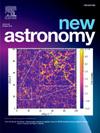Multi-point Hermite methods for the N-body problem
IF 2.1
4区 物理与天体物理
Q2 ASTRONOMY & ASTROPHYSICS
引用次数: 0
Abstract
Numerical integration methods are central to the study of self-gravitating systems, especially those comprised of many bodies or otherwise beyond the reach of analytical methods. Predictor–corrector schemes, both multi-step methods and those based on 2-point Hermite interpolation, have found great success in the simulation of star clusters and other collisional systems. Higher-order methods, such as those based on Gaussian quadratures and Richardson extrapolation, have also proven popular for high-accuracy integrations of few-body systems, particularly those that may undergo close encounters. This work presents a family of high-order schemes based on multi-point Hermite interpolation. When applied as multi-step multi-derivative schemes, these can be seen as generalizing both Adams–Bashforth–Moulton methods and 2-point Hermite methods; I present results for the 6th-, 9th-, and 12th-order 3-point schemes applied in this manner using variable timesteps. In a star cluster-like test problem, the 3-point 6th-order predictor–corrector scheme matches or outperforms the standard 2-point 4th-order Hermite scheme at negligible additional cost, potentially reducing the necessary number of force evaluations in simulations of large- collisional systems by factors of or more. I also present a number of high-order time-symmetric schemes up to 18th order, which have the potential to improve the accuracy and efficiency of long-duration simulations.
n体问题的多点Hermite法
数值积分方法是研究自重力系统的核心,特别是那些由许多物体组成或其他超出分析方法范围的系统。预测校正方案,无论是多步方法还是基于两点埃尔米特插值的方法,在星团和其他碰撞系统的模拟中都取得了巨大的成功。高阶方法,如基于高斯正交和理查德森外推的方法,也被证明是对少体系统的高精度集成的流行,特别是那些可能经历近距离接触的系统。本文提出了一种基于多点Hermite插值的高阶格式。当应用于多步多导数格式时,这些可以看作是Adams-Bashforth-Moulton方法和两点Hermite方法的推广;我给出了使用可变时间步长以这种方式应用的6阶、9阶和12阶3点方案的结果。在类似星团的测试问题中,3点6阶预测校正方案匹配或优于标准的2点4阶埃尔米特方案,而额外的成本可以忽略不计O(N),潜在地将大N碰撞系统模拟中必要的力评估次数减少了~ 3或更多。我还提出了一些高达18阶的高阶时间对称方案,这些方案有可能提高长时间模拟的准确性和效率。
本文章由计算机程序翻译,如有差异,请以英文原文为准。
求助全文
约1分钟内获得全文
求助全文
来源期刊

New Astronomy
地学天文-天文与天体物理
CiteScore
4.00
自引率
10.00%
发文量
109
审稿时长
13.6 weeks
期刊介绍:
New Astronomy publishes articles in all fields of astronomy and astrophysics, with a particular focus on computational astronomy: mathematical and astronomy techniques and methodology, simulations, modelling and numerical results and computational techniques in instrumentation.
New Astronomy includes full length research articles and review articles. The journal covers solar, stellar, galactic and extragalactic astronomy and astrophysics. It reports on original research in all wavelength bands, ranging from radio to gamma-ray.
 求助内容:
求助内容: 应助结果提醒方式:
应助结果提醒方式:


